LinkedIn connection request message is very important for the first impression. But just having a LinkedIn profile or even optimized LinkedIn profile won’t guarantee success. You need to use it the right way to get the results you want.
Use our expert tips on to write the perfect LinkedIn connection request message and benefit from it.
- How to Write a LinkedIn Connection Request Message
- What to Say in a Connection Request Message on LinkedIn
- What NOT to Say in a Connection Request Message on LinkedIn
- 10 Tips to Write an Effective LinkedIn Connection Request Message
- 1. Set the Tone with a Thoughtful Opener
- 2. Introduce Yourself
- 3. Add a Personal Touch
- 4. Show Enthusiasm
- 5. Mention a Mutual Connection
- 6. Offer Value
- 7. Keep it Short and Clear
- 8. Avoid Overly Casual Language
- 9. Look for Typos and Grammatical Errors Before Sending
- 10. Play with Pattern Interrupts
- How to Customize LinkedIn Connection Request
- What Is a LinkedIn Connection Request?
- The Purpose of LinkedIn Connection Request
- Why Are LinkedIn Connection Requests Important?
How to Write a LinkedIn Connection Request Message
Writing personalized messages on LinkedIn may seem time-consuming compared to using standard templates. But don’t fret because, with the right approach, you can streamline the process and send out requests in no time.
Here’s a step-by-step guide to composing the best LinkedIn connection request message:
- Greet with warmth: Start your message with a friendly greeting, addressing the recipient by their first name. And if appropriate, acknowledge any professional titles they hold, such as “Dr;”
- Introduce yourself confidently: Next, clearly state your name and position. If you share a mutual connection, mention them because it adds credibility to your request. For students, make sure to provide relevant details like your grade, school, field of study, and future aspirations, whether it’s pursuing a PhD or seeking internships;
- Share how you found them: After introducing yourself, briefly explain how you found their profile. Did a mutual connection recommend them? Did you meet at a networking event? Or did you come across their profile while browsing LinkedIn job boards?
- Highlight common ground: Identify any shared interests, alma maters, employers, or other relevant similarities between you and the recipient. Finding common ground can help you establish rapport and make your request more compelling;
- State your purpose: The next step is to clearly articulate why you’re reaching out. Are you looking to expand your professional network within your industry? Or are you actively seeking new job opportunities? Remember, being upfront about your intentions fosters transparency and clarity;
- End with appreciation: Finally, wrap up your message with a courteous closing, such as “Thank you for your time” or “I look forward to connecting.” Also, it is good to sign off with your name to add a personal touch.
Throughout your message, make sure to maintain a professional yet friendly tone. Strike a balance between professionalism and approachability. Your message should exude warmth and sincerity while adhering to professional etiquette.
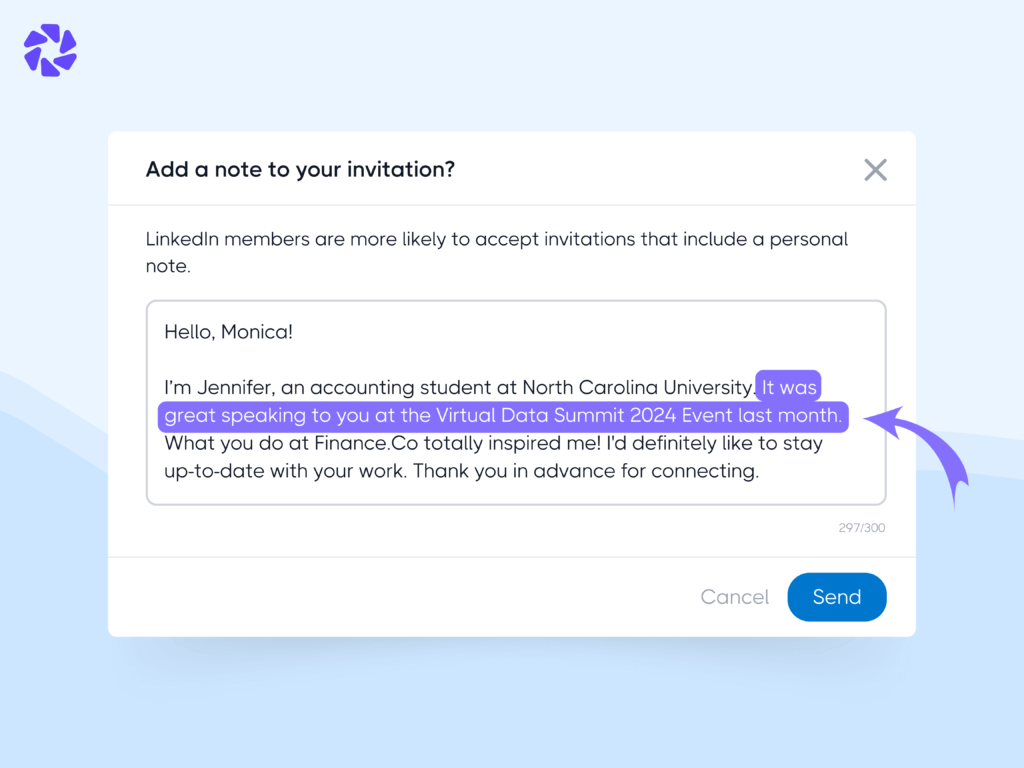
Additionally, you should remember to follow up after sending the request. Whether it’s continuing the conversation online or suggesting a phone call or coffee meeting, nurturing the connection is key to building meaningful relationships.
Here are 20+ LinkedIn connection message templates for any purpose.
What to Say in a Connection Request Message on LinkedIn
It’s no secret that personalizing your message to suit each unique situation is essential for effective LinkedIn networking.
For instance, when reaching out for career advice, it’s vital to tailor your message to highlight specific questions or areas where you need guidance. You can do this by mentioning a shared interest, alma mater, skills, or connection. This approach will demonstrate sincerity and increase the likelihood of receiving a good response.
Similarly, when requesting feedback on application materials, it’s crucial to acknowledge the recipient’s expertise and time.
For example, you might admire their work in the field and politely request their insights on your resume or cover letter. When you contextualize your message, it shows respect for the recipient’s knowledge and increases the chances of your request being accepted.
Also, remember that building long-term relationships on LinkedIn requires consistent engagement and thoughtful communication. This might involve regularly interacting with your connections’ posts, sharing relevant industry articles, or participating in discussions.
What NOT to Say in a Connection Request Message on LinkedIn
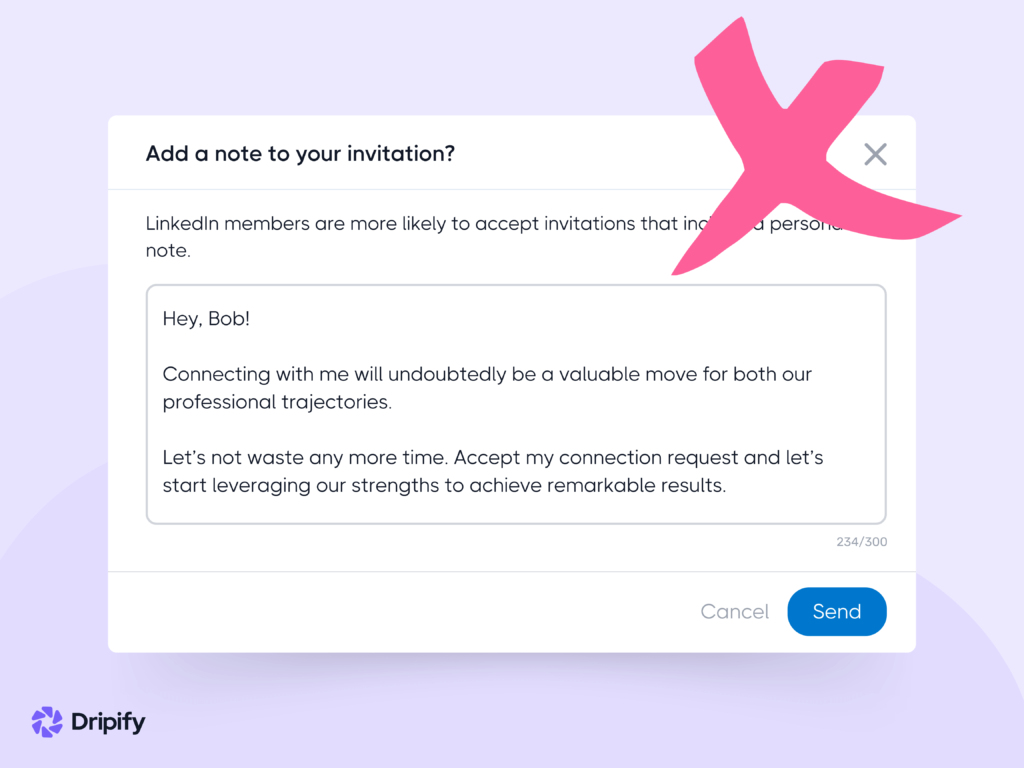
Now that you know how to write a perfect connection request, let’s go over things not to say in your message.
- Avoid overly casual language: LinkedIn is a professional platform, so refrain from using slang, too many emojis, or overly informal language in your connection request;
- Don’t be too generic: Don’t send the same generic message to everyone, as it can come across as impersonal and insincere. Instead, tailor your message to the individual you’re reaching out to. Not doing so will reduce the likelihood of someone wanting to remove connections on LinkedIn;
- Avoid self-promotion: While it’s okay to briefly mention your background or expertise, do not turn your connection request into a sales pitch. Make sure to focus on building a genuine connection rather than promoting yourself or your products/services;
- Don’t ask for favors immediately: When it comes to professional networking, it is about establishing mutually beneficial relationships over time. As such, you shouldn’t ask for favors or assistance in your connection request message;
- Avoid being too lengthy: Keep your message concise. Long, rambling messages can be overwhelming and may deter the recipient from accepting your request. How many characters in a LinkedIn connection request is ideal? You must follow LinkedIn’s character limit of 300 for sending a connection request;
- Don’t forget to proofread: Spelling and grammar mistakes can make you appear unprofessional. So, take the time to proofread your message before sending it to ensure it’s error-free;
- Don’t sound aggressive: Pushy or aggressive language can be off-putting. Instead, be polite and respectful in your approach.
10 Tips to Write an Effective LinkedIn Connection Request Message
1. Set the Tone with a Thoughtful Opener
LinkedIn users get way too many generic connection requests that all sound the same. Most people ignore such requests because they think they’re either spam or not worthwhile.
You should always begin your request on a thoughtful, friendly, and warm note. People are more likely to accept sincere requests.
For example, the opening lines should immediately indicate that you’ve genuinely noticed something about the person you’re sending an invite to. This helps generate curiosity and projects you as someone who wants to connect meaningfully.
Instead of “Hi, let’s connect,” you could use an opener like “Hi [Name], I really enjoyed reading your recent post on [topic]…”
This sort of opening depicts thoughtfulness, purpose, curiosity, and respect. This, in turn, builds trust and increases the chances that the other person will accept your invitation to connect.
2. Introduce Yourself
People have a natural tendency to know about anyone who wants to network with them. So, instead of sending a blank or basic request, share who you are and why you’d like to connect.
Keep your introduction short but meaningful. You could mention your role, your area of interest, or a common point you share with the person, such as an industry, event, or mutual connection.
Examples:
“Hello [Name], my name is David, and I recently started working in digital marketing. I’m eager to connect with experienced professionals like you.”
“Hi [Name], my name is Emma, and I work in financial consulting. I admire your career path and thought it would be great to connect.”
3. Add a Personal Touch
Personalizing your request, even slightly, increases the chances of making a genuine connection. Highlight something meaningful about the recipient from their LinkedIn profile, such as a recent post, a common interest, or an achievement.
This extra step shows that you’ve a genuine interest in connecting. People are more likely to accept tailored, warm, intentional, and relevant connection requests.
Examples:
“Hello [Name], I see you’re working at [Company]. I’ve always admired the work your team is doing, and I’d be glad to connect.”
“Hi [Name], I came across your article on [platform] and found it very useful. I’d love to connect and follow more of your work.”
4. Show Enthusiasm
An enthusiastic and upbeat tone shows genuine interest, positive energy, and a motivation to connect and network. Your connection request message should mention what excites you about the recipient’s work, your shared interest, or why you’re eager to connect.
Examples:
“Hi [Name], it’s fantastic to see the impact you’re making in [industry]. I’d be thrilled to connect and share thoughts on [shared interest]!”
“Hi [Name], I’ve been following your posts on [topic], and they’re always so insightful! I’d be really excited to connect and keep learning from your ideas.”
5. Mention a Mutual Connection
Mentioning a mutual connection in your LinkedIn request is a simple but powerful way to build trust right from the start. When you highlight a person you both know, it creates an instant sense of familiarity. This also shows that you’re not a complete stranger and that your network overlaps.
Examples:
“Hi [Name], I realized we both know [Mutual Connection], which shows how small and well-connected this industry really is. I’d love to connect and expand my network with you.”
“Hi [Name], I noticed we’re both connected with [Mutual Connection]. I’ve really enjoyed working with them, and I thought it would be great to connect with you as well.”
6. Offer Value
Instead of focusing only on what you want, think about offering something valuable to the recipient. This could be an ebook, industry insights, an article, or even a complementary service.
In doing so, ensure that any value you share is relevant to the other person’s needs, priorities, and interests.
When your message highlights value, it shows that you’re approaching the connection with generosity and collaboration in mind, which increases the chances of your request being accepted.
Examples:
“Hi [Name], I’ve been following the challenges in [industry], and I came across some research that could be valuable for your role at [Company]. I’d be glad to connect and send it your way.”
“Hi [Name], I really like the work your company is doing in [industry]. As a way to add value, I’d be happy to provide a free website audit with tips for improving performance. Let’s connect!”
7. Keep it Short and Clear
Keeping your message short and clear makes it easier for the recipient to read and take action. Long or complicated notes can feel overwhelming and confusing, making the other person skip your request altogether.
Your message should clearly state who you are and why you’d like to connect. A concise, well-structured request shows respect for the other person’s time and makes your intention easy to understand.
Example:
“Hi [Name], I’m Alex, a digital marketer focused on LinkedIn outreach. I recently tested a strategy that boosted responses by 30%. Happy to share if we connect.”
“Hi [Name], I see that you’ve worked extensively in [specific field/project]. I recently came across a new resource on [related topic] that I think you’d find valuable. Would love to connect and share!”
8. Avoid Overly Casual Language
While you want to sound approachable, phrases that are too informal, such as “Hey buddy” or “What’s up?” can come across as unprofessional and reduce the chances of your request being accepted.
LinkedIn is a professional platform, and your message should reflect that tone. Write in a warm yet polished style that strikes the right balance between friendliness and professionalism, leaving a positive impression from the very first interaction.
9. Look for Typos and Grammatical Errors Before Sending
Before hitting the Send button, make sure to double-check your connection request note for typos or grammatical mistakes. Small errors may seem harmless, but they can leave a poor first impression. These tiny mistakes can make you come across as careless or unprofessional.
A clean, error-free note shows attention to detail and respect for the recipient. Reading your message out loud or using a tool to catch mistakes can help ensure your request is free of errors.
10. Play with Pattern Interrupts
A pattern interrupt is when you break a predictable flow with something unexpected, playful, or oddly specific. You can use this approach to force the recipient into pausing and paying attention because your connection request note doesn’t fit the usual “script.”
Examples:
“Noticed you’re a fan of long walks and leadership books… I’m convinced those two are connected.”
“I promise this isn’t another pitch, unless you count my pitch for the best coffee in town.”
“I’ll keep this shorter than most connection notes, but I’d value adding your voice to my feed.”See how each one surprises the reader? That tiny break in the rhythm lifts the odds of the person hitting the “accept” button.
How to Customize LinkedIn Connection Request
Now, let’s look at some quick tips to tailor your connection request message on the LinkedIn:
- Mention something specific you found interesting, like a recent achievement or shared interest you saw on their profile;
- Mention mutual connections, industry backgrounds, or common interests;
- Reference any articles, insights, or discussions they’ve shared on LinkedIn;
- Clearly tell why you want to connect and what you hope to get out of it;
- Avoid using generic templates and tailor each message to the individual recipient;
- Want to send an automatic LinkedIn connection request? Be sure to use Dripify, a trusted sales automation tool for sending connection requests in bulk.
Below are two examples for your inspiration:
“Hi John, I saw you got promoted to Senior Marketing Manager. Congrats!! Let’s connect and chat about the latest trends in digital marketing.”
“Hello Sarah, Your recent article on AI integration in marketing was insightful. I found your perspective on data analytics particularly interesting. Let’s connect and discuss further.”
What Is a LinkedIn Connection Request?
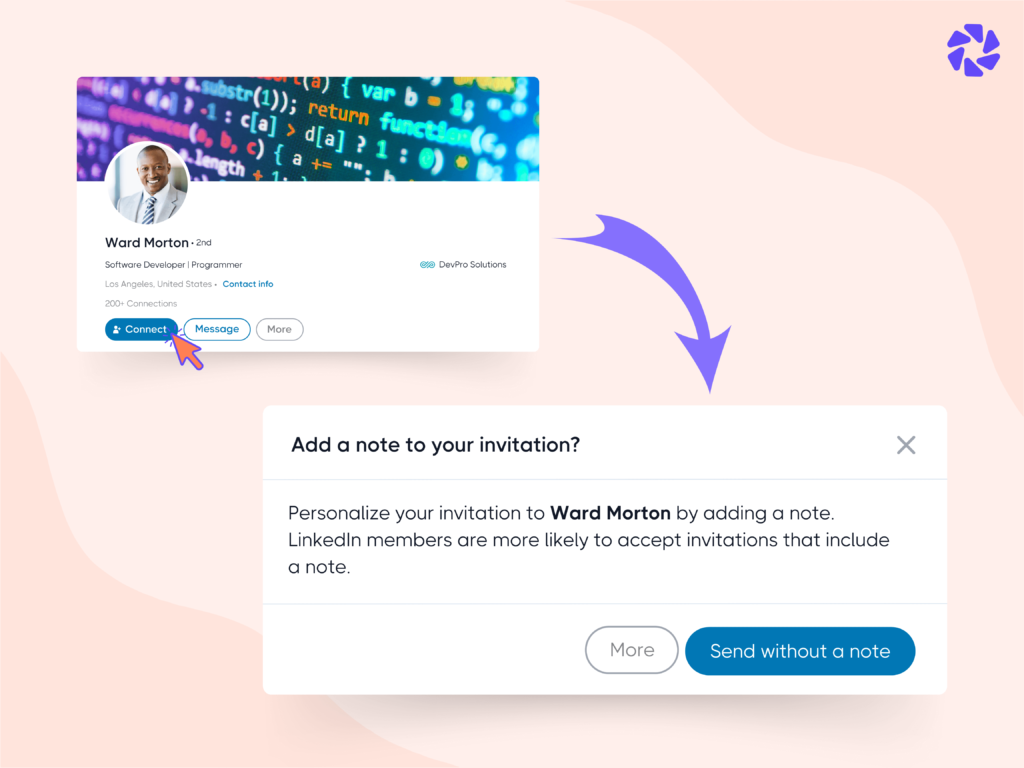
A LinkedIn connection request is simply a way to connect with someone on the platform. It is similar to sending a Facebook friend request.
When you visit someone’s LinkedIn profile and hit “Connect,” you’re given two options:
“Add a Note” and “Send Without a Note.”
If you choose “Send Without a Note,” LinkedIn sends a basic message with your request: “I’d like to add you to my professional network on LinkedIn.”
But this generic message doesn’t help you stand out, especially if you’re trying to reach people who get lots of messages every week.
It is a good idea to choose “Add a Note” because that allows you to include a personalized message in your request. This is your chance to grab someone’s attention and make a connection that could lead to future opportunities.
What is the maximum connection per day that I can send? You can send 20 to 25 requests per day on LinkedIn. That’s the LinkedIn connection request limit that you must keep in mind so your LinkedIn account can have good standing.
Compare LinkedIn InMail vs Connection Request to choose what best suits you.
The Purpose of LinkedIn Connection Request
LinkedIn connection requests are more than just a click of a button. In fact, they’re opportunities to expand your professional network and gain valuable insights.
Here’s why they’re important and what you can achieve with them:
- Networking: Connection requests on LinkedIn enable you to reach out to professionals beyond your current network. It provides you with an opportunity to establish new connections that could lead to collaborations, job opportunities, or mentorship;
- Perception: Before sending a connection request, you get a chance to view the person’s profile. It allows you to gauge how they present themselves professionally and even see their expertise. As such, you get insights into how your potential connection might perceive you in return;
- Exchange of Information: Reaching someone on LinkedIn opens the door for communication even beyond LinkedIn. For instance, you can request their email address to continue discussions or share updates relevant to your respective fields;
- Company Updates: Connecting with individuals in your industry can provide insider insights and opportunities for collaboration. You can also use these connections to stay updated on industry news and developments;
- Professional Research: Before you send a LinkedIn connection request, you may want to explore a person’s profile, including their work history, skills, and endorsements. This information can help tailor your connection request and subsequent interactions;
- Network Expansion: Leveraging mutual contacts is a great way to expand your network further. If someone shares connections with your existing contacts, you may want to send them a request to connect. And when they accept your request, it can introduce you to a broader pool of professionals with similar interests or expertise.
Why Are LinkedIn Connection Requests Important?
LinkedIn connection requests are crucial because they offer a direct way to reach out to professionals, even if you haven’t met them personally. They’re the initial step in establishing relationships, exploring career opportunities, and generating leads for your business.
As you know, the potential of LinkedIn is vast. For B2B businesses, using LinkedIn for lead generation is a fundamental aspect of their marketing strategy on LinkedIn. And without connecting with your target audience, you can’t generate enough leads or boost your sales.
Consider this: the typical company on LinkedIn has over 2,000 connections and is consistently expanding its network. Notably, approximately 80% of Fortune 1000 companies use LinkedIn, making it their preferred choice among social networks.
When you master how to send an excellent connection request, LinkedIn can be effective for generating leads through networking.
Conclusion
Writing a good connection request is key to building valuable professional relationships on LinkedIn. When writing a message to connect on the network, be sure to keep it personalized, find common ground, state your purpose clearly, and end with a friendly invite for further chat.
Networking is about real connections, so keep it genuine!
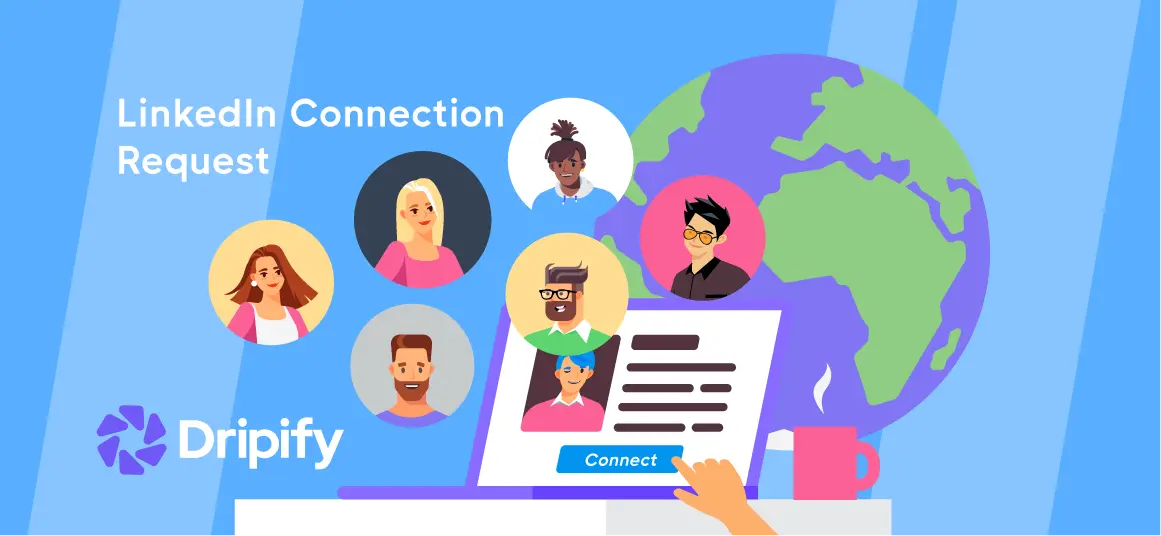
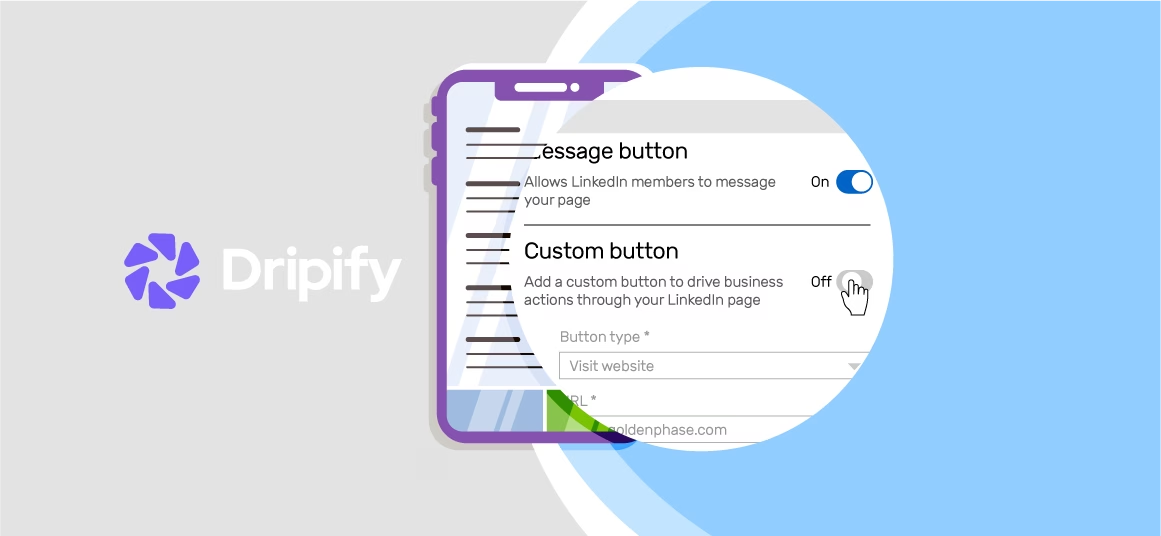
![Email Outreach Tracking [Tips, Tricks and Tools]](https://dripify.com/wp-content/uploads/2025/02/11-7-png.avif)
![Create a Prospecting Plan [+8 Prospecting Methods]](https://dripify.com/wp-content/uploads/2025/02/11-png.avif)